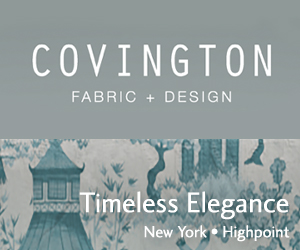Henderson, Van Driessche Anticipate Ragolle, Beaulieu Market Share Gains Next Year in Rugged Sales Arena
July 25, 2018
WAREGEM, BE—Tessutica, the parent company of Ragolle and Beaulieu fabric brands, expects to carve out more business in the years ahead at the expense of the competition, according to the new general manager Karl Henderson, who took the post earlier this year.
He says the fabric market is not growing, but “by developing new technological products and giving the best service and good quality, we want to take over a part of the market of our competitors.”
“Our business is doing around $23.5 million turnover a year,” Henderson explains. “We have 108 looms to realize this production. For the moment, 2017 and 2018 were difficult years to maintain our turnover. We expect a yearly growth from 2019 on by five percent a year, in order to achieve a $30 million business unit in the future.”
Beaulieu is a contemporary designed brand with dobby plains, while Ragolle is composed of traditional jacquards. The collections sell from $4-$12 a meter. Henderson says he started the operation to bring Ragolle and Beaulieu production together in a brand-new building in Ploesti, Romania, “respecting the handwriting and the production process of each individual brand,” he says. He followed Luc and Christa Vande Wiele, who left the company two years ago. “Although the production happens in Romania, we still do development, creation, and have the sales team in Belgium,” he adds.
Tessutica is owned by Beaulieu International Group, which is primarily a carpet and rug manufacturer. “The sofa business is changing every day,” says Annette Van Driessche, Tessutica brand and commerce manager, who works closely with Henderson. “It is influenced by e-commerce, the import of Chinese goods, the change in consumer behavior; consumers tend to spend more for holidays, restaurants, and well-being—things that bring direct pleasure,” she says.
“The UK is our biggest export market, and it is suffering from the Brexit story. As a result, we are expanding worldwide sales in order to be less dependent on the UK. A major part of the design effort is to produce customer-driven designs. We see that our customers are moving more and more of their production to low-cost countries,” she says. “We continue to market European developed products based on over 60 years' experience with a clear focus on efficiency, in order to always be competitive.”

He says the fabric market is not growing, but “by developing new technological products and giving the best service and good quality, we want to take over a part of the market of our competitors.”
“Our business is doing around $23.5 million turnover a year,” Henderson explains. “We have 108 looms to realize this production. For the moment, 2017 and 2018 were difficult years to maintain our turnover. We expect a yearly growth from 2019 on by five percent a year, in order to achieve a $30 million business unit in the future.”
Beaulieu is a contemporary designed brand with dobby plains, while Ragolle is composed of traditional jacquards. The collections sell from $4-$12 a meter. Henderson says he started the operation to bring Ragolle and Beaulieu production together in a brand-new building in Ploesti, Romania, “respecting the handwriting and the production process of each individual brand,” he says. He followed Luc and Christa Vande Wiele, who left the company two years ago. “Although the production happens in Romania, we still do development, creation, and have the sales team in Belgium,” he adds.
Tessutica is owned by Beaulieu International Group, which is primarily a carpet and rug manufacturer. “The sofa business is changing every day,” says Annette Van Driessche, Tessutica brand and commerce manager, who works closely with Henderson. “It is influenced by e-commerce, the import of Chinese goods, the change in consumer behavior; consumers tend to spend more for holidays, restaurants, and well-being—things that bring direct pleasure,” she says.
“The UK is our biggest export market, and it is suffering from the Brexit story. As a result, we are expanding worldwide sales in order to be less dependent on the UK. A major part of the design effort is to produce customer-driven designs. We see that our customers are moving more and more of their production to low-cost countries,” she says. “We continue to market European developed products based on over 60 years' experience with a clear focus on efficiency, in order to always be competitive.”

















